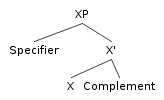Specifier
In X-bar theory in linguistics, specifiers, head words, complements and adjuncts together form phrases. Specifiers differ from complements and adjuncts because they are non-recursive, as you can only have one specifier.[1] They are not sisters of the head, but rather sisters of the phrase formed by the head and the complement or adjunct. In English, some example of specifiers are determiners such as the, a, this, quantifiers such as no, some, every, and possessives such as John’s and my mother’s, which can precede noun phrases. Verb phrases can be preceded by quantifiers such as each, and all. Adjective phrases and adverbial phrases can be preceded by degree words such as very, extremely, rather and quite.[2]
These specifiers are so called because they further qualify the category of the head - in these examples nouns and adverbs - in the phrase.
For example:
- My friend likes [Jane Austen’s novels] - Jane Austen’s specifies novels in this noun phrase
- She is [quite certain of success] - quite specifies certain of success in the adverbial phrase quite certain of success
In recent transformational grammar, the term specifier is not normally used to refer to a type of word or phrase, but rather to a structural position provided by X-bar theory or some derivative thereof. In this usage, a phrase (usually a full XP, though in bare phrase structure it could in theory be an intermediate category) is said to occupy the specifier (SpecXP for short) of a head X.
In technical syntax terminology, specifier is a YP that is the sister of X′, and the daughter of XP. The rule is XP → (YP) X′, where YP is the specifier. The X-bar schema of this phrase structure can be seen in the tree diagram below (where XP corresponds to X″):

Different form classes can occupy a specifier position, typically determiners and possessors in noun phrases (N″), and an auxiliary verb in a verb phrase (V″).